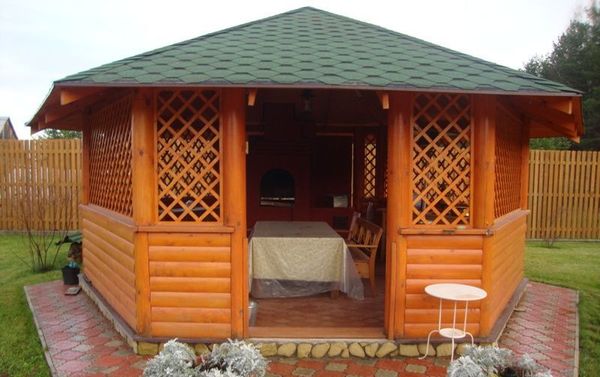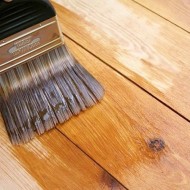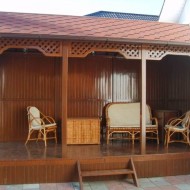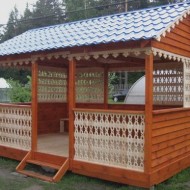How to handle a wooden gazebo on the street: 5 effective tools
Content
Why processing is needed
Wood processing allows you to protect it from the destructive effects of ultraviolet radiation, as well as from fungus, mold, insects. Otherwise, within 1–2 years the tree will lose about 90% of its mechanical stability, and the structure will simply collapse. Another impregnation will help preserve the natural pattern of the wood cut, and if paint is planned to be applied on top, the treatment will reduce its consumption by 50-60%.
Another important nuance: wood impregnation must be performed in several passes. This is true for primers, natural and synthetic oils. Only in this case the wooden gazebo can be protected by 99% from environmental influences.
Video "Budget method of wood processing"
From this video you will learn how to process wood from moisture and decay at no cost.
Means options
According to the composition of the impregnation for wood, it can be divided into:
- Antiseptics. For gazebos that are operated on the street, they are mandatory, as they prevent the occurrence of mold and mildew. It is impossible to prevent spores from entering the tree, but an antiseptic will prevent them from germinating. Some of the most popular: Farbex, "Titan" (S series).
- Oils. The most common options are linseed oil and drying oil. They protect against moisture. If you process a tree with them, then the coefficient of its moisture absorption will decrease to about 0.2%. Accordingly, moisture will not accumulate in the wood and freeze in winter, which is why cracks most often appear.
- Primers. It is recommended to cover the wood with such a product before painting - this increases adhesion, prevents cracking and fading of the paint layer. By the way, there are also primers with antiseptic additives. In many cases it is better to use them. Popular models: Pinotex, Kompozit.
- Varnish. It completely covers the wood, therefore it is applied only to well-dried wood. It allows you to preserve the natural pattern of wood materials, but at the same time it perfectly protects against moisture, fungi, mold, ultraviolet radiation. Popular models: Euromix, Mav Brava.
- Dye. It is better to use oil-based, as it penetrates deeply into the structure of the tree, does not create an external polymer film. But the consumption turns out to be quite large, even with preliminary priming. Popular paints: Kompozit, Bayris.
Processing technology
For maximum protection of boards or timber, they must be processed using the following technology:
- The first layer is a deeply penetrating antiseptic. It is recommended to use combined antiseptics containing both an oil base and synthetic additives. It should be processed in 2-3 layers.
- The second layer is oil impregnation, drying oil or linseed oil. Apply with a brush, carefully "rub" into the wood, wipe the rest with a soft sponge. If there is a lot of oil and it is not completely absorbed, a sticky stain will remain. It is better to treat the floor with linseed oil. It contains synthetic additives that are more aggressive against mold and mildew.
- Primer.If the above steps are followed, then apply in one layer. You can choose with a dye base to lighten or darken wood.
- Dye.
This technique is used to process new wood. If the timber or boards have already been used before, then they are preliminarily sanded. Can also be planed to a depth of 1 mm.
Previously painted wood is simply sanded with a belt sander. A more aggressive option is sanding with an angle grinder with an emery wheel. This method is suitable for cases where there are traces of shallow corrosion on the wood.
Finishing
With paint, everything is extremely simple: it is applied with a brush or roller, it can be in two layers, but letting the first layer dry completely. Varnish is covered in 2–4 layers, depending on the tone of the coating, which must be obtained in the end. You should not use a spray gun, it is better to give preference to ordinary brushes with natural bristles.
Thus, there are many options for processing an open and closed gazebo. The main thing is to prevent moisture absorption, since only at high humidity does fungus and mold grow. Keep in mind that it is much easier to process before assembling the structure.




